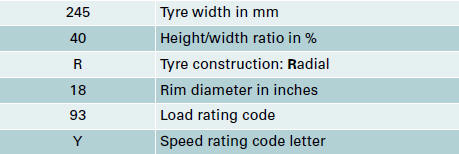Replacing wheels and tyres
It is important to use the correct wheels and tyres when replacement is necessary.
Ц All four wheels must be fitted with tyres of the same type,
size (rolling circumference) and preferably the same
tread pattern.
Ц If possible, tyres should be replaced at least in pairs and
not individually (i.e. both front tyres or both rear tyres
together).
Ц Never use tyres whose actual size exceeds the dimensions
of the factory-approved makes of tyre.
Ц If you wish to fit the vehicle with non-standard rims or
tyres, it is advisable to consult an Audi dealer before
purchasing them.
The tyres and wheel rims are an essential part of the vehicle's
design. The tyres and rims approved by Audi are specially matched
to the characteristics of the vehicle and make a major contribution
to good roadholding and safe handling ⇒
 .
.
The sizes of the rims and tyres approved for your vehicle are listed in the vehicle's documents (e.g. EC Certificate of Conformity or COC document 5)). The vehicle documents vary depending on the country of residence.
Understanding the tyre designations makes it easier to choose the correct tyres. For example, radial ply tyres have the following tyre designations marked on the sidewall:
245 / 40 R 18 93 Y
This contains the following information:

The manufacturing date is also indicated on the tyre sidewall (possibly only on the inner side of the wheel):
DOT ... 1006...
means, for example, that the tyre was produced in the 10th week of 2006.
Please note that with some types of tyres, the actual tyre size can differ from the nominal size marked on the tyre (for instance 245/40 R 18 93 Y), and there may be significant differences in the contours of the tyres, even though the tyres are marked with the same nominal size designation. When replacing the tyres, it is therefore important to make sure that the actual size of the new tyres does not exceed the dimensions of the factory-approved makes of tyre.
Failure to observe this requirement can affect the clearance needed
for the tyres. This could result in contact between the tyres and
suspension components or bodywork. The brake lines could also be
damaged and the vehicle's safety could be severely impaired ⇒
 .
.
When using tyres with the maximum permitted nominal dimensions, this can also void the vehicle's registration.
If you use tyres that are approved by Audi you can be sure that the actual tyre dimensions will be correct for your vehicle. If you decide to fit a different type of tyre, you must obtain the appropriate manufacturer's certificate from the tyre retailer to confirm that the tyres are suitable for your vehicle. Keep this certificate in a safe place.
Your local Audi dealer will be able to advise you on which tyres may be fitted to your vehicle.
All four wheels must always be fitted with tyres of the same type, make and tread pattern, otherwise the drive-line can be damaged by the constant differences in wheel speeds. For the same reason, only use a spare wheel* with the same tyre dimensions as the normal road wheels.
It the spare tyre* is not the same type as the tyres fitted on the car (for example if the car has winter tyres or wide-section tyres) you should only use the spare tyre if a puncture occurs, and then only for a short period of time. In this case, please drive with extra care.
Refit the normal road wheel as soon as possible.
It is best to have all servicing of wheels and tyres performed by a qualified workshop. They have the necessary special tools and replacement parts, trained personnel and facilities for disposing of the old tyres.
 WARNING
WARNING
Х It is very important to ensure that the tyres you have chosen
have adequate clearance. When selecting replacement tyres, do
not rely entirely on the nominal tyre size marked on the tyre; with
some makes of tyre the effective tyre size can differ significantly
from the nominal dimensions, even though the tyres have the
same size designation. Inadequate tyre clearance can result in
damage to the tyres or the vehicle, causing a serious safety risk. It
may also invalidate the vehicle's type approval for use on public
roads.
Х Please ask your Audi dealer or qualified workshop whether run
flat tyres can be used on your vehicle. Unauthorised use of these
tyres can invalidate the vehicle's type approval for use on public
roads. Furthermore, this could cause damage to your vehicle and
possibly also result in an accident.
Х Avoid running the car on tyres that are more than 6 years old.
If you have no alternative, you should drive slowly and with extra
care at all times.
For the sake of the environment
Old tyres must be disposed of according to the laws in the country
concerned.
 Note
Note
Х Never mount used tyres if you are not sure of their previous
history.
Х For technical reasons it is not normally possible to use wheel
rims from other vehicles. In some cases this also applies to rims
from other vehicles of the same model.
